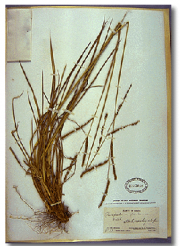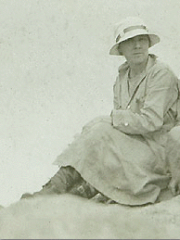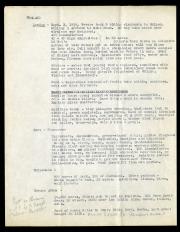Sharing Plants, Animals, and Friendships


Exchanging specimens is essential in botanical research: Herbaria swap their duplicates in return for specimens they lack. Such international trading is based on relations established through correspondence and research trips, relations that endure through generations of botanists. By the early twentieth century, trading was well established between the Smithsonian and Latin American botanists.
In 1924 an intrepid woman botanist from the U.S. National Herbarium set off alone for a season of fieldwork in eastern Brazil. Agnes Chase wanted to see living examples of the grasses pressed in her herbarium and to collect species new to science. Most important, she planned to meet colleagues she had corresponded with for decades -- scientists in schools, botanical gardens, and agriculture departments throughout Latin America.

 With Doña María Bandeira, a specialist on mosses at Brazil's Jardim Botanico, Chase shared interests and made connections with other botanists. Traveling by train, donkey and foot to Serra da Gamma, Chase climbed Mount Itatiaia and found a myriad of new specimens. Although warned of the dangers of traveling alone in the wilds, she was undeterred. Her diary notes, "The guide said we might lose our lives -- but what is life without the plants we came for?"
With Doña María Bandeira, a specialist on mosses at Brazil's Jardim Botanico, Chase shared interests and made connections with other botanists. Traveling by train, donkey and foot to Serra da Gamma, Chase climbed Mount Itatiaia and found a myriad of new specimens. Although warned of the dangers of traveling alone in the wilds, she was undeterred. Her diary notes, "The guide said we might lose our lives -- but what is life without the plants we came for?"
Chase, who often remarked that grasses hold the earth together, was passionately devoted to their study. Like most botanists, she established extensive networks for trading specimens with other herbaria. When her career started, the National Herbarium had very few Latin American specimens. Through correspondence and later through fieldwork, Chase developed a strong collection of Latin American grasses. The path between North and South was well worn, with Chase traveling south and botanists traveling north to study with her. She mentored many Latin American botany students, arranging for extended visits to the Smithsonian, and often hosted visiting scholars in her home. Her First Book of Grasses, translated into Spanish in 1959, introduced Latin American students to the amazing plant world around them.


 The Manns traveled to Argentina in 1939 to exchange animals and ideas. They knew their hosts well through years of correspondence, and visiting the zoos at Cordoba and La Plata allowed them to exchange ideas about caring for and displaying animals. Lucy Mann marveled at the displays in the Cordoba Zoo, which seemed part of the natural landscape.
The Manns traveled to Argentina in 1939 to exchange animals and ideas. They knew their hosts well through years of correspondence, and visiting the zoos at Cordoba and La Plata allowed them to exchange ideas about caring for and displaying animals. Lucy Mann marveled at the displays in the Cordoba Zoo, which seemed part of the natural landscape.
 Buffaloes from North America found a new home in the tropics, and iguanas from the pampas became the latest attraction in Washington, D.C. When the Manns returned, their lectures and exhibits taught North Americans about animals they had only seen before in books.
Buffaloes from North America found a new home in the tropics, and iguanas from the pampas became the latest attraction in Washington, D.C. When the Manns returned, their lectures and exhibits taught North Americans about animals they had only seen before in books.
Chase, Bandeira, and Mann were among a small but growing group of women entering scientific research and education. They had a special understanding for their sisters in science that transcended barriers of language and geography. The trips to Latin America were adventures of a lifetime, memorable for plants and animals collected and enduring friendships.



